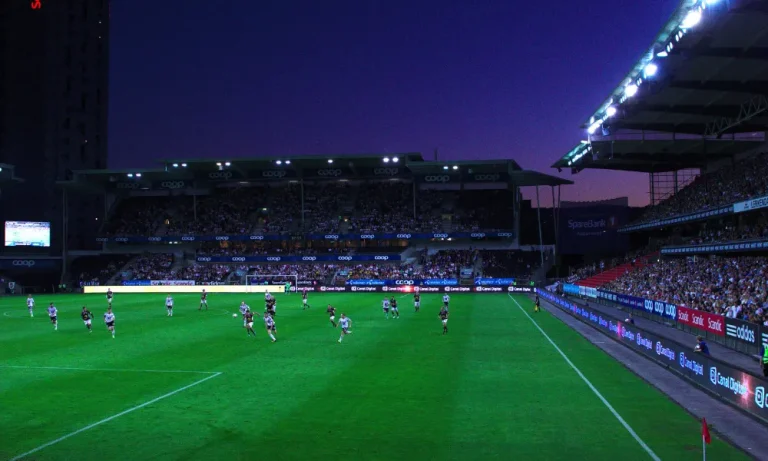What is a Post Route in Football?
Have you ever wondered what a post route in football is? Well, you’re in the right place! In this blog post, we’ll explore the definition of a post route and delve into its importance in offensive strategies. We’ll also touch upon other common football routes to provide a holistic understanding of the game. So, let’s dive in and uncover the secrets behind this key offensive maneuver!
Anatomy of a Post Route
The primary objective of a post route is to create separation from the defender and make a deep, angled cut towards the center of the field. This route is commonly used to attack the middle of the defense and exploit any openings in coverage. By running a post route, I aim to stretch the defense vertically and create opportunities for big gains.
To execute a post route effectively, it’s crucial to have a precise initial release and stem. I start by sprinting off the line of scrimmage, aiming to gain leverage on the defender. As I approach the top of my stem, I make a sharp cut at a 45-degree angle towards the center of the field. This sudden change of direction helps me create separation from the defender and establish a favorable position.
The route’s break and angle towards the center of the field are key components of its success. As I reach the top of my stem, I plant my outside foot and explode towards the inside. This break allows me to quickly change direction and head towards the center of the field. By angling my route towards the center, I put myself in a prime position to receive the ball and exploit any gaps in coverage.
Timing and coordination between the quarterback and receiver are paramount for a successful post route. The receiver’s break and angle must align with the quarterback’s timing and anticipation. The quarterback needs to release the ball just as the receiver makes his break, ensuring the pass arrives in the right spot at the right time. This synchronization is essential to maximize the route’s effectiveness and increase the chances of a completion.
Key Elements of a Successful Post Route
When it comes to executing a successful post route, there are several key elements to keep in mind. First and foremost, the receiver’s speed and acceleration off the line play a crucial role. Bursting off the line with explosive speed can catch defenders off guard and create separation, giving the quarterback a clear target downfield.
Precise footwork is another essential aspect of a well-executed post route. Every step counts, and maintaining proper footwork throughout the route is vital. I focus on taking clean, efficient steps, ensuring that I maintain balance and control as I make my way towards the center of the field. This attention to detail in my footwork allows me to change direction quickly and maintain my speed.
Creating separation from defenders is a top priority when running a post route. I employ various strategies to outmaneuver the defenders and gain an advantage. Using subtle head fakes or shoulder dips can throw off the defender’s timing and create enough space to make a clean catch. Additionally, utilizing my body positioning and leverage against the defender can help me gain an edge and create separation.
Maintaining balance and body control throughout the route is essential for a successful post route. I focus on staying low and balanced, allowing me to make sharp cuts and change direction smoothly. By keeping my center of gravity low and my body under control, I can quickly adjust to the ball’s trajectory and make the necessary adjustments to secure the catch.
Variations and Adjustments
The post route offers various variations that can be utilized to keep the defense guessing. Two common variations are the skinny post and the deep post. The skinny post involves a sharper, more vertical cut towards the center of the field, while the deep post emphasizes a longer, more gradual angle. These variations provide different options to attack the defense based on the situation and the coverage.
Adjustments play a crucial role in the success of a post route, especially when facing different defensive coverages. Against man-to-man coverage, I focus on using my speed and agility to create separation from the defender. Adjusting my route based on the defender’s positioning and leverage allows me to exploit any weaknesses and gain an advantage.
When facing zone coverage, reading and exploiting the defense’s vulnerabilities become essential. I pay close attention to the positioning of the defenders and identify the open zones. By finding the soft spots in the zone, I can adjust my route to exploit those areas and provide a clear target for the quarterback. This requires a keen understanding of defensive schemes and the ability to recognize and react to the coverage in real-time.
Common Mistakes and How to Avoid Them
Identifying common mistakes made by receivers and quarterbacks is crucial for improvement. One common mistake for receivers is running imprecise routes. To avoid this, I focus on practicing my footwork and route-running technique diligently. By maintaining proper footwork and executing precise cuts, I can create separation from defenders and increase the chances of completing the route successfully.
For quarterbacks, timing and accuracy are key areas of focus. One mistake often seen is throwing the ball either too early or too late, resulting in an incomplete pass. To improve timing, I work on developing a strong rapport with my receivers, studying their movement patterns, and practicing timing routes extensively. Additionally, improving accuracy requires honing my throwing mechanics, such as footwork, arm motion, and release point, through dedicated practice and repetition.
Coaches play a vital role in helping players correct their mistakes. Through drills and practice, coaches can provide valuable feedback and guidance. They may incorporate route-running drills, emphasizing proper footwork and precision. Quarterbacks can benefit from specific drills that focus on timing and accuracy, simulating game-like scenarios. By providing targeted instruction and constructive feedback, coaches can help players overcome their mistakes and improve their overall performance on the field.
Famous Players Known for their Post Routes
Introduction to notable NFL receivers who excelled at running post routes is essential for understanding the impact of this route on their careers. One such receiver is Randy Moss. Moss was known for his exceptional speed and ability to create separation on post routes. His long strides and precise cuts made it challenging for defenders to keep up, resulting in numerous big plays and touchdowns.
Another notable player renowned for his post route skills is Jerry Rice. Rice’s precise route-running and exceptional hands made him a nightmare for opposing defenses. He had a knack for finding open zones in the defense and exploiting them with his post routes. Rice’s ability to consistently make big plays and score touchdowns greatly contributed to his successful career and the team’s success.
FAQs
What is a post route in football?
A post route is a passing route where the receiver sprints straight down the field before angling toward the goalpost, creating an opportunity for a deep pass.
How is a post route different from other routes?
Unlike other routes, the post route involves a diagonal cut towards the center of the field, aiming to exploit the open space between defenders.
What are the key elements of running a successful post route?
Key elements include speed, precise footwork, timing, and the ability to read the defense to find the open space for the reception.
What is the primary objective of a post route?
The primary objective of a post route is to stretch the defense vertically and create separation from defenders, allowing for a potential deep pass completion.
Which positions typically run post routes?
Wide receivers, tight ends, and occasionally running backs are the positions most commonly tasked with running post routes in football.
Conclusion
Post routes in football are a vital component of offensive strategies. Their ability to create opportunities for big gains and touchdowns makes them a valuable tool for players and coaches alike. As the game of football continues to evolve, incorporating post routes into offensive game plans becomes even more crucial. So, whether you’re a player looking to improve your skills or a coach seeking to enhance your team’s performance, don’t overlook the power of post routes. Embrace their effectiveness and watch your game reach new heights!






